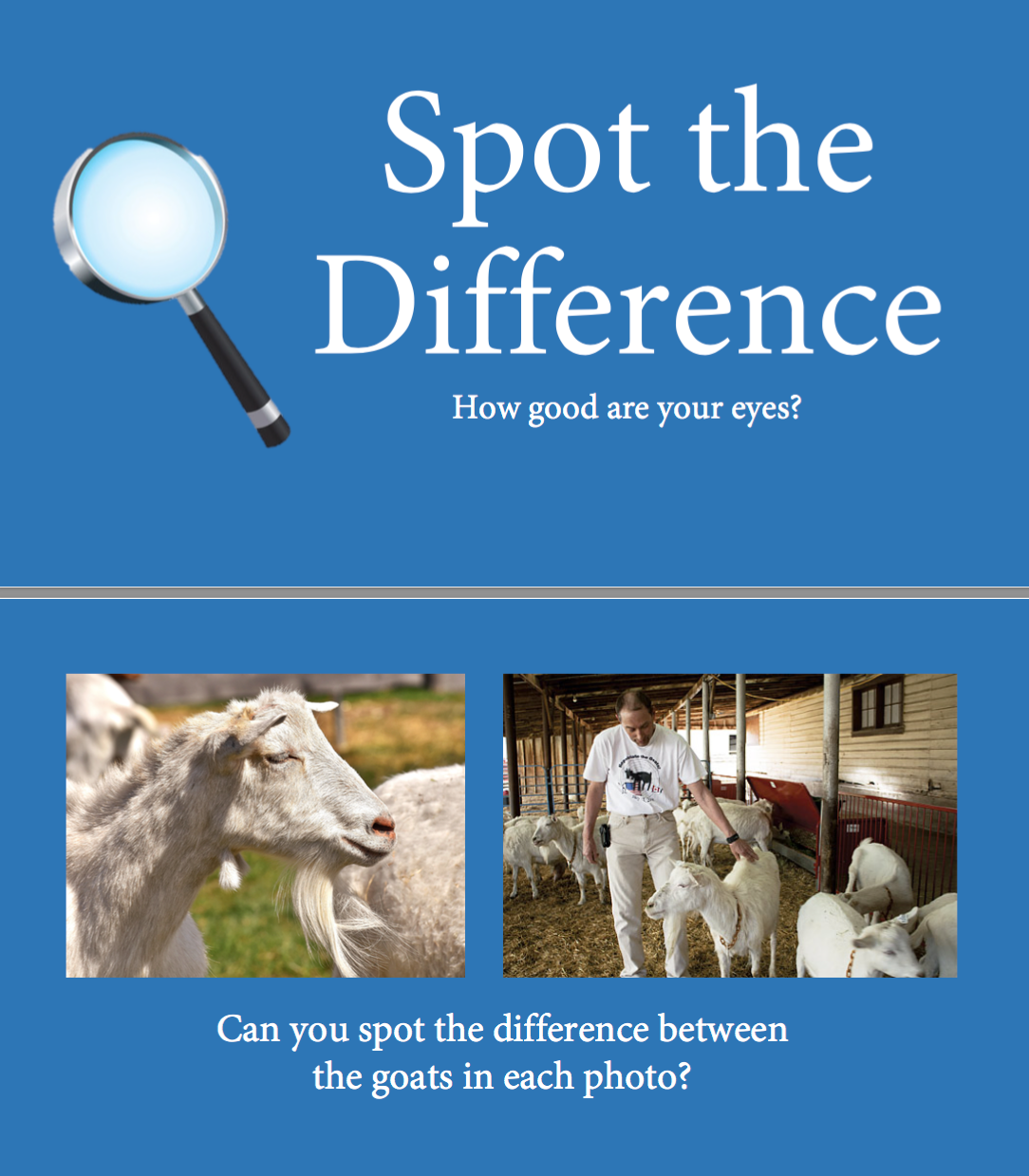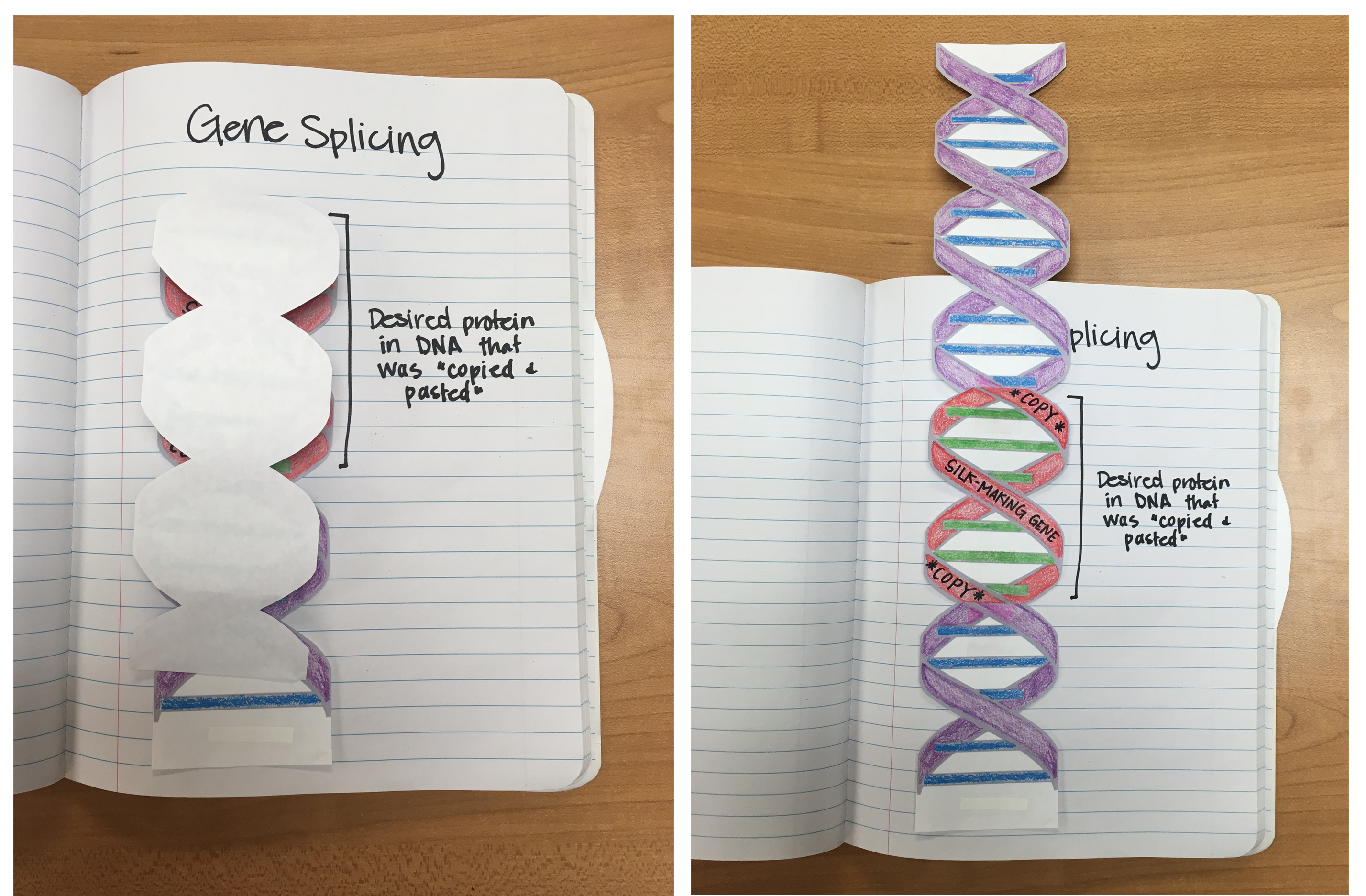Silky Genes
Students will simulate the process of gene splicing, understand the application of transgenic organisms in agriculture, and see how goats can be used for the production of goods other than meat and milk through the use of biotechnology.

Background
Lesson Activities
Recommended Companion Resources
Credits
Author
Bekka Israelsen | Utah Agriculture in the Classroom
Sources
- http://www.ansi.okstate.edu/breeds/goats/
- https://www.thejudgingconnection.com/pdfs/670_Comparing_Dairy_Goats_To_Cows.pdf
- Spider goat image found on Spot the Difference PowerPoint courtesy of USU.
- https://www.deseretnews.com/article/705375752/A-web-of-possibilities-Utah-researcher-uses-goats-to-make-one-of-the-strongest-known-substances.html
- https://www.youtube.com/watch?v=xossR6eHv3I&t=99s
- https://www.youtube.com/watch?v=2nya8sPWKOA (toothpaste reference)
- http://knowgenetics.org/recombinant-dna-technology/
- https://www.theguardian.com/science/2012/jan/14/synthetic-biology-spider-goat-genetics
- http://archive.industry.gov.au/Biotechnologyonline.gov.au/topitems/glossary.html#gene
Standards
Texas Content Area Standards
-
World Geography Studies: 113.43.d.21
Social studies skills. The student applies critical-thinking skills to organize and use information acquired through established research methodologies from a variety of valid sources, including technology. The student is expected to:
- World Geography Studies: 113.43.d.21.D: analyze information by sequencing, categorizing, identifying cause-and-effect relationships, comparing, contrasting, finding the main idea, summarizing, making generalizations and predictions, drawing inferences and conclusions, and developing connections over time
- World Geography Studies: 113.43.d.21.F: formulate and communicate visually, orally, or in writing a claim supported by evidence and reasoning for an intended audience and purpose
-
Economics with Emphasis on the Free Enterprise System and Its Benefits: 113.31.d.21
Social studies skills. The student applies critical-thinking skills to organize and use information acquired through established research methodologies from a variety of valid sources, including technology. The student is expected to:
- Economics with Emphasis on the Free Enterprise System and Its Benefits: 113.31.d.21.A: analyze economic information by sequencing, categorizing, identifying cause-and-effect relationships, comparing, contrasting, finding the main idea, summarizing, making generalizations and predictions, and drawing inferences and conclusions
- Economics with Emphasis on the Free Enterprise System and Its Benefits: 113.31.d.21.F: formulate and communicate visually, orally, or in writing a claim supported by evidence and reasoning for an intended audience and purpose
-
English I: 110.36.c.1
Developing and sustaining foundational language skills: listening, speaking, discussion, and thinking--oral language. The student develops oral language through listening, speaking, and discussion.
- English I: 110.36.c.1.D: participate collaboratively, building on the ideas of others, contributing relevant information, developing a plan for consensus building, and setting ground rules for decision making
-
English I: 110.36.c.11
Inquiry and research: listening, speaking, reading, writing, and thinking using multiple texts. The student engages in both short-term and sustained recursive inquiry processes for a variety of purposes.
- English I: 110.36.c.11.A: develop questions for formal and informal inquiry
- English I: 110.36.c.11.E: locate relevant sources
- English I: 110.36.c.11.F: synthesize information from a variety of sources
- English I: 110.36.c.11.I: use an appropriate mode of delivery, whether written, oral, or multimodal, to present results
-
English II: 110.37.c.1
Developing and sustaining foundation language skills: listening, speaking, discussion, and thinking--oral language. The student develops oral language through listening, speaking, and discussion.
- English II: 110.37.c.1.D: participate collaboratively, building on the ideas of others, contributing relevant information, developing a plan for consensus building, and setting ground rules for decision making
-
English III: 110.38.c.1
Developing and sustaining foundational language skills: listening, speaking, discussion, and thinking--oral language. The student develops oral language through listening, speaking, and discussion.
- English III: 110.38.c.1.D: participate collaboratively, offering ideas or judgments that are purposeful in moving the team toward goals, asking relevant and insightful questions, tolerating a range of positions and ambiguity in decision making, and evaluating the work of the group based on agreed-upon criteria
-
English II: 110.37.c.11
Inquiry and research: listening, speaking, reading, writing, and thinking using multiple texts. The student engages in both short-term and sustained recursive inquiry processes for a variety of purposes.
- English II: 110.37.c.11.A: develop questions for formal and informal inquiry
- English II: 110.37.c.11.E: locate relevant sources
- English II: 110.37.c.11.F: synthesize information from a variety of sources
- English II: 110.37.c.11.I: use an appropriate mode of delivery, whether written, oral, or multimodal, to present results
-
English III: 110.38.c.11
Inquiry and research: listening, speaking, reading, writing, and thinking using multiple texts. The student engages in both short-term and sustained recursive inquiry processes for a variety of purposes.
- English III: 110.38.c.11.A: develop questions for formal and informal inquiry
- English III: 110.38.c.11.E: locate relevant sources
- English III: 110.38.c.11.F: synthesize information from a variety of sources
- English III: 110.38.c.11.I: use an appropriate mode of delivery, whether written, oral, or multimodal, to present results
-
English IV: 110.39.c.1
Developing and sustaining foundational language skills: listening, speaking, discussion, and thinking--oral language. The student develops oral language through listening, speaking, and discussion.
- English IV: 110.39.c.1.D: participate collaboratively, offering ideas or judgments that are purposeful in moving the team toward goals, asking relevant and insightful questions, tolerating a range of positions and ambiguity in decision making, and evaluating the work of the group based on agreed-upon criteria
-
English IV: 110.39.c.11
Inquiry and research: listening, speaking, reading, writing, and thinking using multiple texts. The student engages in both short-term and sustained recursive inquiry processes for a variety of purposes.
- English IV: 110.39.c.11.A: develop questions for formal and informal inquiry
- English IV: 110.39.c.11.E: locate relevant sources
- English IV: 110.39.c.11.F: synthesize information from a variety of sources
- English IV: 110.39.c.11.I: use an appropriate mode of delivery, whether written, oral, or multimodal, to present results
-
Advanced Animal Science: 130.10.c.1
The student demonstrates professional standards/employability skills as required by business and industry. The student is expected to:
- Advanced Animal Science: 130.10.c.1.B: apply competencies related to resources, information, interpersonal skills, and systems of operation in animal systems.
-
Advanced Animal Science: 130.10.c.8
The student applies the principles of molecular genetics and heredity. The student is expected to:
- Advanced Animal Science: 130.10.c.8.D: explain the functions of DNA and RNA.
- Advanced Animal Science: 130.10.c.8.E: describe how heredity is used in the selection of livestock such as knowing the difference between outbreeding and inbreeding/linebreeding.
- Advanced Animal Science: 130.10.c.8.F: explain how traits are passed from parent to offspring through genetic transfer and the implications of breeding practices.
-
World History Studies: 113.42.d.28
Social studies skills. The student understands how historians use historiography to interpret the past and applies critical-thinking skills to organize and use information acquired from a variety of valid sources, including technology. The student is expected to:
- World History Studies: 113.42.d.28.E: analyze information by sequencing, categorizing, identifying cause-and-effect relationships, comparing, contrasting, finding the main idea, summarizing, making generalizations and predictions, drawing inferences and conclusions, and developing connections between historical events over time
- World History Studies: 113.42.d.28.F: formulate and communicate visually, orally, or in writing a claim supported by evidence and reasoning for an intended audience and purpose
-
Biology: 112.42.c.1
Scientific and engineering practices. The student, for at least 40% of instructional time, asks questions, identifies problems, and plans and safely conducts classroom, laboratory, and field investigations to answer questions, explain phenomena, or design solutions using appropriate tools and models. The student is expected to:
- Biology: 112.42.c.1.A: ask questions and define problems based on observations or information from text, phenomena, models, or investigations
- Biology: 112.42.c.1.E: collect quantitative data using the International System of Units (SI) and qualitative data as evidence
- Biology: 112.42.c.1.F: organize quantitative and qualitative data using scatter plots, line graphs, bar graphs, charts, data tables, digital tools, diagrams, scientific drawings, and student-prepared models
- Biology: 112.42.c.1.G: develop and use models to represent phenomena, systems, processes, or solutions to engineering problems
-
Biology: 112.42.c.2
Scientific and engineering practices. The student analyzes and interprets data to derive meaning, identify features and patterns, and discover relationships or correlations to develop evidence-based arguments or evaluate designs. The student is expected to:
- Biology: 112.42.c.2.A: identify advantages and limitations of models such as their size, properties, and materials
- Biology: 112.42.c.2.B: analyze data by identifying significant statistical features, patterns, sources of error, and limitations
-
Biology: 112.42.c.3
Scientific and engineering practices. The student develops evidence-based explanations and communicates findings, conclusions, and proposed solutions. The student is expected to:
- Biology: 112.42.c.3.A: develop explanations and propose solutions supported by data and models and consistent with scientific ideas, principles, and theories
- Biology: 112.42.c.3.B: communicate explanations and solutions individually and collaboratively in a variety of settings and formats
- Biology: 112.42.c.3.C: engage respectfully in scientific argumentation using applied scientific explanations and empirical evidence
-
Biology: 112.42.c.4
Scientific and engineering practices. The student knows the contributions of scientists and recognizes the importance of scientific research and innovation on society. The student is expected to:
- Biology: 112.42.c.4.A: analyze, evaluate, and critique scientific explanations and solutions by using empirical evidence, logical reasoning, and experimental and observational testing, so as to encourage critical thinking by the student
- Biology: 112.42.c.4.C: research and explore resources such as museums, libraries, professional organizations, private companies, online platforms, and mentors employed in a science, technology, engineering, and mathematics (STEM) field in order to investigate STEM careers
-
Biology: 112.42.c.7
Science concepts--mechanisms of genetics. The student knows the role of nucleic acids in gene expression. The student is expected to:
- Biology: 112.42.c.7.A: identify components of DNA, explain how the nucleotide sequence specifies some traits of an organism, and examine scientific explanations for the origin of DNA
- Biology: 112.42.c.7.B: describe the significance of gene expression and explain the process of protein synthesis using models of DNA and ribonucleic acid (RNA)
- Biology: 112.42.c.7.C: identify and illustrate changes in DNA and evaluate the significance of these changes
- Biology: 112.42.c.7.D: discuss the importance of molecular technologies such as polymerase chain reaction (PCR), gel electrophoresis, and genetic engineering that are applicable in current research and engineering practices


